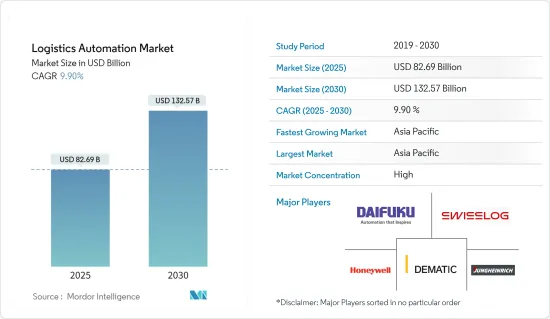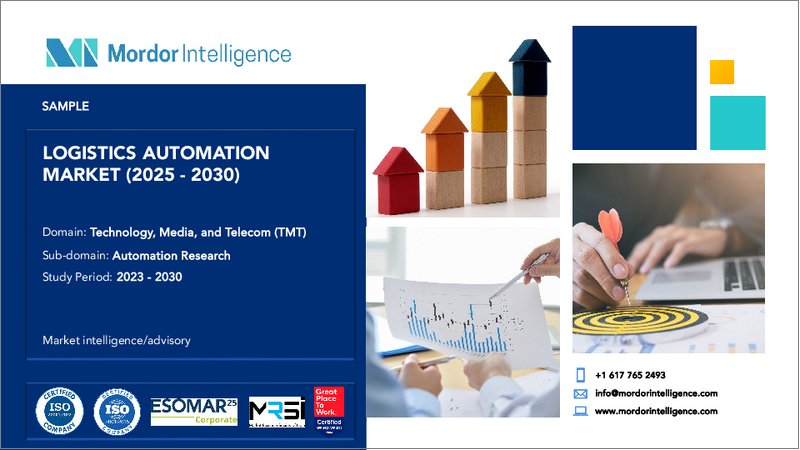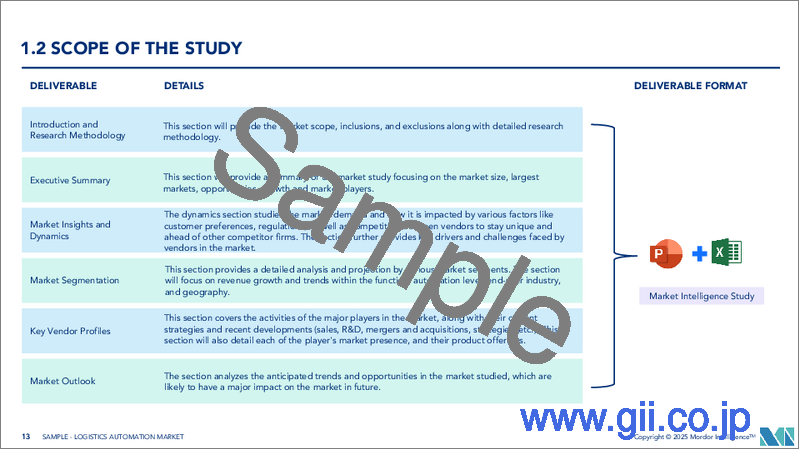|
|
市場調査レポート
商品コード
1687705
ロジスティクスオートメーション:市場シェア分析、産業動向・統計、成長予測(2025年~2030年)Logistics Automation - Market Share Analysis, Industry Trends & Statistics, Growth Forecasts (2025 - 2030) |
||||||
カスタマイズ可能
適宜更新あり
|
|||||||
| ロジスティクスオートメーション:市場シェア分析、産業動向・統計、成長予測(2025年~2030年) |
|
出版日: 2025年03月18日
発行: Mordor Intelligence
ページ情報: 英文 120 Pages
納期: 2~3営業日
|
全表示
- 概要
- 目次
ロジスティクスオートメーション市場規模は2025年に826億9,000万米ドルと推定され、予測期間中(2025-2030年)のCAGRは9.9%で、2030年には1,325億7,000万米ドルに達すると予測されます。

主なハイライト
- 複雑化する製造工程が自動化を促進:製造プロセスの複雑化により、ロジスティクスオートメーションシステムの導入が加速しています。倉庫の規模は劇的に拡大し、平均倉庫面積は2000年の65,000平方フィートから200,000平方フィート超へと3倍に拡大しました。このような規模拡大により、倉庫自動化技術に対する需要が大幅に高まっています。こうした問題に対処するため、企業は自動マテリアルハンドリングシステムや自律移動ロボット(AMR)のような先進的なソリューションに目を向けています。代表的な例として、Integrated Supply Network社がKorberとLocus RoboticsのAMRを49台導入した結果、生産性が266%向上し、ピッキング効率が1時間当たり30ピックから110ピックに急増しました。
- 作業員の安全性と効率の向上:自動化技術の導入により、ロジスティクス環境における労働者の安全性と作業効率が大幅に向上しています。米国労働統計局によると、保管・倉庫業では年間15,000件以上の労働関連事故が報告されており、この業界の安全リスクが浮き彫りになっています。ライトガイドドッキングソリューションや自動保管・検索システム(ASRS)を含むロジスティクスオートメーションシステムは、これらの危険を軽減するのに役立ちます。さらに、自動化システムはヒューマンエラーを排除し、24時間365日稼働するため、休憩やシフトチェンジの必要なく高い生産性を保証します。
- ロジスティクスの形を変える技術の進歩:IoT、人工知能(AI)、機械学習などの最先端技術のロジスティクス・オートメーションへの統合は、業界に革命をもたらしています。これらの進歩は、リアルタイムのデータ処理、スマートな倉庫管理、意思決定の強化を促進します。例えば、アマゾンが20万台以上の移動ロボットを配備したことは、サプライチェーンの自動化から車両管理まですべてを最適化し、ロジスティクスにおけるロボット工学の変革力を浮き彫りにしています。AIを活用した倉庫管理システムの利用が拡大しており、サービスレベルの向上、オペレーションのボトルネックの削減、全体的な効率性の向上につながっています。
- 競合情勢と投資動向:ロジスティクスオートメーション市場は比較的細分化されており、Kion Group、ダイフク、ハネウェルなどの業界リーダーが一貫したイノベーションと戦略的投資を通じて市場の成長を牽引しています。これらの企業は、ロジスティクスや無人搬送車(AGV)における先進的なロボティクスでポートフォリオを強化することに注力しています。特筆すべき開発は、Agility Roboticsが2023年3月に発表した多用途物流ロボットDigitで、これはバルクマテリアルハンドリングに革命を起こそうとしています。さらに、英国を拠点とするBotsAndUsが倉庫の自動化を強化するために2022年に1,230万ユーロ(1,375万米ドル)を調達しているように、市場ではAIを活用したロジスティクスオートメーション動向への投資が活発化しています。
- 将来の展望と機会:ロジスティクス・オートメーション業界の展望は、センサー、AI、データ分析を組み込んだ自律型システムの普及による将来の著しい成長を示唆しています。Robotics-as-a-Service(RaaS)は、先行コストを削減し、拡張性を提供することで、自動化物流システムの幅広い採用を可能にする、ゲームチェンジャーとして台頭しつつあります。自動搬送車(AGV)と自律移動ロボット(AMR)は、消費者セクターと産業セクターの両方で利用が増加しており、ロジスティクスオートメーションの展望を支配すると予想されます。高度な自動化技術をうまく統合し、進化する市場の需要に適応する企業は、この拡大する市場でリーダーシップを確保すると思われます。
ロジスティクスオートメーション市場の動向
市場情勢を支配する倉庫オートメーション
倉庫オートメーション市場情勢を支配する倉庫オートメーション
- トップシェア:倉庫自動化技術は、ロジスティクスオートメーション市場の大部分を占め、2022年には41.58%の圧倒的な市場シェアを占める。2022年に263億1,000万米ドルと評価されたこのセグメントは、CAGR 10.01%で成長し、2028年には459億2,000万米ドルに達すると予測されています。需要の原動力となっているのは、急速なeコマースの拡大と、自動化を取り入れたスマートなフルフィルメントセンターのニーズです。
- 効率化を促進する技術の進歩:自動マテリアルハンドリングシステムやAI主導の分析などの革新は、倉庫自動化プロセスを大幅に強化しています。物流における高度なロボット工学、センサー、IoTの利用は、リアルタイムの在庫追跡を可能にし、人的介入を減らし、サプライチェーン全体のオペレーションを合理化しています。AIを搭載したロジスティクスオートメーションソフトウェアの統合は、倉庫全体の効率を向上させる上で極めて重要な要素です。
- eコマースブームが市場成長を後押し:eコマースの急増は、自動倉庫の需要拡大の主な原動力となっています。米国の小売eコマース売上高は、2022年第4四半期に2,619億7,000万米ドルに達し、より高い注文量をサポートするためのロジスティクスオートメーションの必要性を強調しています。eコマース大手は、この成長を効果的に処理するため、スマート倉庫ソリューションへの投資を優先しています。
- 倉庫数の増加が需要を押し上げる:世界中で倉庫施設の数が増加していることが、ロジスティクスオートメーション市場の成長に寄与しています。複雑なサプライチェーンを管理するために自動化されたロジスティクスシステムへの依存度が高まっていることを反映して、米国だけでも倉庫事業者数は2016年の16,992社から2021年には20,002社に増加しています。
- 新たなビジネスモデルロボティクス・アズ・ア・サービス(RaaS)は、手頃な価格でスケーラブルな自動化ソリューションを提供し、市場で人気を集めています。完全所有の経済的負担なしに最先端技術へのアクセスを提供することで、RaaSは小売、eコマース、サードパーティー・ロジスティクスなどの分野の企業の参入障壁を低くしています。
輸送オートメーション:急成長セグメント
- 高い成長の可能性:倉庫の自動化が最大のシェアを占める一方で、輸送の自動化はロジスティクスオートメーション業界で最も急成長しているセグメントです。この分野は、自律型配送システム、スマート輸送管理システム(TMS)、AI主導型物流ソリューションの進歩により、CAGR 10.77%を達成すると予測されています。自律走行車の配備の増加は、ロジスティクス業務の輸送面を再構築しています。
アジア太平洋:ロジスティクスオートメーションの成長エンジン
- 市場をリード:アジア太平洋地域は、2022年に47.16%のシェアを獲得し、世界のロジスティクスオートメーション市場を独占しています。この地域は2028年までに228億4,000万米ドルに成長し、10.99%の堅調なCAGRによって主導権を維持すると予測されています。ロジスティクスオートメーションシステムの需要は、中国、日本、オーストラリアなどの主要市場におけるeコマースと製造業の拡大によって促進されています。
- eコマースと製造業が地域の成長を牽引:アジア太平洋諸国における急速な工業化とeコマースの導入は、同地域におけるロジスティクス・オートメーション動向の成長に大きく寄与しています。例えば、世界第11位にランクされるオーストラリアのeコマース部門は、2024年までに323億米ドルの収益を生み出すと予測されています。
- 戦略的投資と拡大:ロジスティクス・オートメーション市場の主要企業は、アジア太平洋地域に多額の投資を行っています。2022年12月、オムロン株式会社はシンガポールにロジスティクスオートメーションセンターを開設し、東南アジアとオセアニアの自動化ソリューションの需要拡大に対応することを目指しています。
- 政府の取り組みがロボティクス導入を後押しアジア全域で政府が支援するイニシアチブが、ロジスティクスにおけるインテリジェント・ロボティクスの導入を促進しています。韓国が2022年のロボット技術革新に1億7,220万米ドルを割り当てたことは、この地域がロジスティクスオートメーション技術の進歩に注力していることを例証しています。
ロジスティクスオートメーション産業の概要
世界プレーヤーがかなり統合された市場を独占ロジスティクス・オートメーション市場は、Robert Dematics Group、Honeywell International Inc.、Daifukuのような世界的リーダー企業によって支配されており、これらの企業は合計で市場シェアの26%以上を占めています。これらの企業は、SSI Schaefer AGとともに、ロジスティクス・オートメーション・システムのイノベーションを推進し続け、最先端のソリューションと戦略的パートナーシップを通じて市場での存在感を維持しています。
イノベーションと戦略的パートナーシップは、市場のリーダーシップを牽引する:ロジスティクス・オートメーション分野の主要企業は、一貫した研究開発投資とロジスティクスにおけるロボット工学の革新を通じて、その優位性を維持しています。例えば、KNAPP社のOpen Shuttle ForkやKardex GroupのAutoStoreシステムは、ロジスティクス・オートメーションにおける新たな基準を打ち立てています。さらに、FANUC AmericaとBosch Rexrothのようなパートナーシップは、その能力と市場範囲を拡大し、協調戦略の重要性を強調しています。
ロジスティクスオートメーション市場における将来の成功要因:この競争の激しい市場で成功するためには、企業はAIを搭載したロボティクス、IoT統合、拡張性のあるオートメーションシステムの開発などの技術的進歩に注力する必要があります。また、ウォルマートによるアラート・イノベーションの買収が示すように、製品ポートフォリオを拡大するためにはM&Aも鍵となります。企業は、この急速に進化する状況の中で優位に立つことを確実にするために、特定の業界のニーズに合わせたロジスティクスオートメーションソリューションを提供する必要があります。
その他の特典
- エクセル形式の市場予測(ME)シート
- 3ヶ月間のアナリスト・サポート
目次
第1章 イントロダクション
- 調査の前提条件と市場定義
- 調査範囲
第2章 調査手法
第3章 エグゼクティブサマリー
第4章 市場洞察
- 市場概要
- 業界の魅力度-ポーターのファイブフォース分析
- 供給企業の交渉力
- 買い手の交渉力
- 新規参入業者の脅威
- 代替品の脅威
- 競争企業間の敵対関係の強さ
- 業界バリューチェーン分析
- COVID-19の市場への影響とその他のマクロ経済要因の分析
第5章 市場力学
- 市場促進要因
- ロジスティクスの形を変える技術の進歩
- 製造の複雑化と技術の利用可能性の向上
- 効率性と労働安全性の向上
- 市場の課題
- 高額な設備投資
第6章 市場セグメンテーション
- 倉庫自動化市場
- コンポーネント別
- ハードウェア
- 移動ロボット(AGV、AMR)
- 自動保管・検索システム(AS/RS)
- 自動仕分けシステム
- デパレタイジング/パレタイジングシステム
- コンベアシステム
- 自動認識・データ収集(AIDC)
- オーダーピッキング
- ソフトウェア
- サービス
- エンドユーザー産業別
- 飲食品
- 郵便・小包
- 食料品
- 一般商品
- アパレル
- 製造業
- その他エンドユーザー産業
- 地域別
- 北米
- 欧州
- アジア
- オーストラリア・ニュージーランド
- ラテンアメリカ
- 中東・アフリカ
- コンポーネント別
- 輸送自動化の世界市場シナリオ
- その他の世界の輸送自動化市場シナリオ
第7章 競合情勢
- 企業プロファイル
- Dematic Corp.(Kion Group AG)
- Daifuku Co. Limited
- Swisslog Holding AG(KUKA AG)
- Honeywell International Inc.
- Jungheinrich AG
- Murata Machinery Ltd
- Knapp AG
- TGW Logistics Group GmbH
- Kardex Group
- Mecalux SA
- Beumer Group GmbH & Co. KG
- SSI Schaefer AG
- Vanderlande Industries BV
- WITRON Logistik
- Oracle Corporation
- One Network Enterprises Inc.
- SAP SE
- ベンダー市場シェア分析
第8章 投資分析
第9章 市場機会と将来の成長
The Logistics Automation Market size is estimated at USD 82.69 billion in 2025, and is expected to reach USD 132.57 billion by 2030, at a CAGR of 9.9% during the forecast period (2025-2030).

Key Highlights
- Manufacturing Complexity Fueling Automation Adoption: The growing complexity in manufacturing processes is accelerating the adoption of logistics automation systems. Warehouse sizes have expanded dramatically, with average warehouse space tripling from 65,000 sq. ft. in 2000 to over 200,000 sq. ft. This scale-up has led to a significant demand for warehouse automation technology, as it becomes increasingly challenging to manage higher volumes and an ever-growing variety of SKUs. To address these issues, companies are turning to advanced solutions like automated material handling systems and autonomous mobile robots (AMRs). A prime example is the 266% productivity increase achieved by Integrated Supply Network after deploying 49 AMRs from Korber and Locus Robotics, with picking efficiency skyrocketing from 30 to 110 picks per hour.
- Workforce Safety and Efficiency Improvements: The introduction of automation technologies is substantially enhancing workforce safety and operational efficiency in logistics environments. According to the U.S. Bureau of Labor Statistics, over 15,000 work-related incidents are reported annually in storage and warehousing, highlighting the industry's safety risks. Logistics automation systems, including light-guided docking solutions and automated storage and retrieval systems (ASRS), help mitigate these hazards. Additionally, automated systems eliminate human error and operate 24/7, ensuring higher productivity without the need for breaks or shift changes.
- Technological Advancements Reshaping Logistics: The integration of cutting-edge technologies such as IoT, artificial intelligence (AI), and machine learning into logistics automation is revolutionizing the industry. These advancements facilitate real-time data processing, smart warehousing, and enhanced decision-making. For instance, Amazon's deployment of over 200,000 mobile robots underscores the transformative power of robotics in logistics, optimizing everything from supply chain automation to fleet management. The growing use of warehouse execution systems, powered by AI, is improving service levels, reducing operational bottlenecks, and elevating overall efficiency.
- Competitive Landscape and Investment Trends: The logistics automation market is relatively fragmented, with industry leaders like Kion Group, Daifuku, and Honeywell driving market growth through consistent innovation and strategic investments. These companies focus on enhancing their portfolios with advanced robotics in logistics and automated guided vehicles (AGVs). A notable development is the March 2023 launch of Digit, a versatile logistics robot by Agility Robotics, which is set to revolutionize bulk material handling. Furthermore, the market is witnessing robust investments in AI-powered logistics automation trends, as seen with UK-based BotsAndUs raising EUR 12.3 million (USD 13.75 million) in 2022 to enhance warehouse automation.
- Future Outlook and Opportunities: The logistics automation industry outlook suggests significant future growth driven by the proliferation of autonomous systems embedded with sensors, AI, and data analytics. Robotics-as-a-Service (RaaS) is emerging as a game-changer, enabling broader adoption of automated logistics systems by reducing upfront costs and offering scalability. Automated guided vehicles (AGVs) and autonomous mobile robots (AMRs) are expected to dominate the logistics automation landscape, with increasing use in both consumer and industrial sectors. Companies that successfully integrate advanced automation technologies and adapt to evolving market demands will secure leadership in this expanding market.
Logistics Automation Market Trends
Warehouse Automation Dominating the Market Landscape
Warehouse Automation: Dominating the Market Landscape
- Leading market share: Warehouse automation technology accounts for a significant portion of the logistics automation market, holding a dominant 41.58% market share in 2022. This segment, valued at USD 26.31 billion in 2022, is forecast to grow at a CAGR of 10.01%, reaching USD 45.92 billion by 2028. The demand is being driven by rapid e-commerce expansion and the need for smart fulfillment centers that incorporate automation.
- Technological advancements driving efficiency: Innovations such as automated material handling systems and AI-driven analytics are significantly enhancing warehouse automation processes. The use of advanced robotics, sensors, and IoT in logistics is enabling real-time inventory tracking, reducing human intervention, and streamlining operations across the supply chain. The integration of AI-powered logistics automation software is a crucial factor in improving overall warehouse efficiency.
- E-commerce boom propelling market growth: The e-commerce surge is a primary driver behind the growing demand for automated warehousing. U.S. retail e-commerce sales reached USD 261.97 billion in Q4 2022, emphasizing the need for logistics automation to support higher order volumes. E-commerce giants are prioritizing investments in smart warehousing solutions to handle this growth effectively.
- Rising number of warehouses boosting demand: The increasing number of warehousing facilities worldwide is contributing to the growth of the logistics automation market. The U.S. alone saw warehousing enterprises grow from 16,992 in 2016 to 20,002 in 2021, reflecting a greater reliance on automated logistics systems to manage complex supply chains.
- Emerging business models: Robotics-as-a-Service (RaaS) is gaining traction in the market, offering affordable and scalable automation solutions. By providing access to cutting-edge technology without the financial burden of full ownership, RaaS lowers barriers to entry for companies in sectors such as retail, e-commerce, and third-party logistics.
Transportation Automation: The Fast-Growing Segment
- High-growth potential: While warehouse automation commands the largest share, transportation automation is the fastest-growing segment in the logistics automation industry. This sector is projected to achieve a CAGR of 10.77%, driven by advancements in autonomous delivery systems, smart transportation management systems (TMS), and AI-driven logistics solutions. The increasing deployment of autonomous vehicles is reshaping the transportation aspect of logistics operations.
Asia-Pacific: The Growth Engine of Logistics Automation
- Leading the market: The Asia-Pacific region dominates the global logistics automation market with a 47.16% share in 2022. This region is forecast to maintain its leadership, growing to USD 22.84 billion by 2028, driven by a robust CAGR of 10.99%. The demand for logistics automation systems is fueled by the expansion of e-commerce and manufacturing in key markets such as China, Japan, and Australia.
- E-commerce and manufacturing driving regional growth: Rapid industrialization and e-commerce adoption across Asia-Pacific countries are significant contributors to the growth of logistics automation trends in the region. For example, Australia's thriving e-commerce sector, ranked eleventh globally, is forecast to generate USD 32.3 billion in revenue by 2024.
- Strategic investments and expansions: Key players in the logistics automation market are investing heavily in the Asia-Pacific region. In December 2022, Omron Corporation opened a logistics automation center in Singapore, aiming to cater to Southeast Asia and Oceania's growing demand for automation solutions.
- Government initiatives boosting robotics adoption: Government-backed initiatives across Asia are promoting the adoption of intelligent robotics in logistics. South Korea's USD 172.2 million allocation to robotics innovation for 2022 exemplifies the region's focus on advancing logistics automation technology.
Logistics Automation Industry Overview
Global players dominate a fairly consolidated market: The logistics automation market is dominated by global leaders like Robert Dematics Group, Honeywell International Inc., and Daifuku Co. Ltd., which collectively account for over 26% of the market share. These companies, along with SSI Schaefer AG, continue to drive innovation in logistics automation systems and maintain a strong market presence through cutting-edge solutions and strategic partnerships.
Innovation and strategic partnerships drive market leadership: Leading companies in the logistics automation sector maintain their edge through consistent R&D investments and innovation in robotics in logistics. For example, KNAPP's Open Shuttle Fork and Kardex Group's AutoStore system are setting new standards in logistics automation. Additionally, partnerships like that between FANUC America and Bosch Rexroth have expanded their capabilities and market reach, highlighting the importance of collaborative strategies.
Factors for future success in the Logistics Automation Market: To thrive in this highly competitive market, companies need to focus on technological advancements such as AI-powered robotics, IoT integration, and developing scalable automation systems. Mergers and acquisitions are also key to expanding product portfolios, as demonstrated by Walmart's acquisition of Alert Innovation. Companies must provide tailored logistics automation solutions to meet specific industry needs, ensuring they stay ahead in this rapidly evolving landscape.
Additional Benefits:
- The market estimate (ME) sheet in Excel format
- 3 months of analyst support
TABLE OF CONTENTS
1 INTRODUCTION
- 1.1 Study Assumptions and Market Definition
- 1.2 Scope of the Study
2 RESEARCH METHODOLOGY
3 EXECUTIVE SUMMARY
4 MARKET INSIGHTS
- 4.1 Market Overview
- 4.2 Industry Attractiveness - Porter's Five Forces Analysis
- 4.2.1 Bargaining Power of Suppliers
- 4.2.2 Bargaining Power of Buyers
- 4.2.3 Threat of New Entrants
- 4.2.4 Threat of Substitute Products and Services
- 4.2.5 Intensity of Competitive Rivalry
- 4.3 Industry Value Chain Analysis
- 4.4 Analysis of COVID-19 Aftereffects and Other Macroeconomic Factors on the Market
5 MARKET DYNAMICS
- 5.1 Market Drivers
- 5.1.1 Technological Advancements Reshaping Logistics
- 5.1.2 Increasing Manufacturing Complexity and Technology Availability
- 5.1.3 Improved Efficiency and Workforce Safety
- 5.2 Market Challenges
- 5.2.1 High Capital Investment
6 MARKET SEGMENTATION
- 6.1 Warehouse Automation Market
- 6.1.1 By Component
- 6.1.1.1 Hardware
- 6.1.1.1.1 Mobile Robots (AGV, AMR)
- 6.1.1.1.2 Automated Storage and Retrieval Systems (AS/RS)
- 6.1.1.1.3 Automated Sorting Systems
- 6.1.1.1.4 De-palletizing/Palletizing Systems
- 6.1.1.1.5 Conveyor Systems
- 6.1.1.1.6 Automatic Identification and Data Collection (AIDC)
- 6.1.1.1.7 Order Picking
- 6.1.1.2 Software
- 6.1.1.3 Services
- 6.1.2 By End-user Industry
- 6.1.2.1 Food and Beverage
- 6.1.2.2 Post and Parcel
- 6.1.2.3 Groceries
- 6.1.2.4 General Merchandise
- 6.1.2.5 Apparel
- 6.1.2.6 Manufacturing
- 6.1.2.7 Other End-user Industries
- 6.1.3 By Geography***
- 6.1.3.1 North America
- 6.1.3.2 Europe
- 6.1.3.3 Asia
- 6.1.3.4 Australia and New Zealand
- 6.1.3.5 Latin America
- 6.1.3.6 Middle East and Africa
- 6.1.1 By Component
- 6.2 Global Transportation Automation Market Scenario
- 6.3 Other Global Transportation Automation Market Scenarios
7 COMPETITIVE LANDSCAPE
- 7.1 Company Profiles
- 7.1.1 Dematic Corp. (Kion Group AG)
- 7.1.2 Daifuku Co. Limited
- 7.1.3 Swisslog Holding AG (KUKA AG)
- 7.1.4 Honeywell International Inc.
- 7.1.5 Jungheinrich AG
- 7.1.6 Murata Machinery Ltd
- 7.1.7 Knapp AG
- 7.1.8 TGW Logistics Group GmbH
- 7.1.9 Kardex Group
- 7.1.10 Mecalux SA
- 7.1.11 Beumer Group GmbH & Co. KG
- 7.1.12 SSI Schaefer AG
- 7.1.13 Vanderlande Industries BV
- 7.1.14 WITRON Logistik
- 7.1.15 Oracle Corporation
- 7.1.16 One Network Enterprises Inc.
- 7.1.17 SAP SE
- 7.2 Vendor Market Share Analysis





